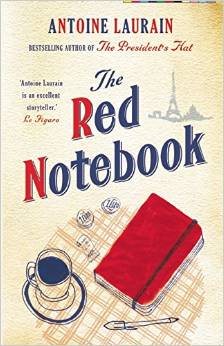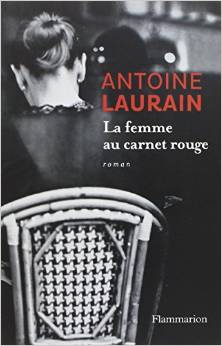A
Literary Saloon
&
Site of Review.
Trying to meet all your book preview and review needs.
| Main |
 |
| the Best |
| the Rest |
| Review Index |
| Links |



to e-mail us:

support the site
The Red Notebook
by
Antoine Laurain
general information | review summaries | our review | links | about the author
| Title: | The Red Notebook |
| Author: | Antoine Laurain |
| Genre: | Novel |
| Written: | 2014 (Eng. 2015) |
| Length: | 159 pages |
| Original in: | French |
| Availability: | The Red Notebook - US |
| The Red Notebook - UK | |
| The Red Notebook - Canada | |
| La femme au carnet rouge - Canada | |
| La femme au carnet rouge - France | |
| Liebe mit zwei Unbekannten - Deutschland | |
| La donna dal taccuino rosso - Italia |
- French title: La femme au carnet rouge
- Translated by Jane Aitken and Emily Boyce
- Return to top of the page -
Our Assessment:
B : has an easy-going charm
See our review for fuller assessment.
| Source | Rating | Date | Reviewer |
|---|---|---|---|
| The Telegraph | A | 8/4/2015 | Christian House |
From the Reviews:
- "It is a set-up worthy of an Ealing comedy. (...) This is in equal parts an offbeat romance, detective story and a clarion call for metropolitans to look after their neighbours. Rather than a version of Notting Hill for the St-Germain set, the story is more personal and jagged." - Christian House, The Telegraph
Please note that these ratings solely represent the complete review's biased interpretation and subjective opinion of the actual reviews and do not claim to accurately reflect or represent the views of the reviewers. Similarly the illustrative quotes chosen here are merely those the complete review subjectively believes represent the tenor and judgment of the review as a whole. We acknowledge (and remind and warn you) that they may, in fact, be entirely unrepresentative of the actual reviews by any other measure.
- Return to top of the page -
The complete review's Review:
The Red Notebook repeatedly invokes Sophie Calle, down to the character whose notebook features so prominently in the novel wondering: "what Sophie Calle would have done with a story like hers".
It's safe to say: not this.
Laurain's aesthetics are colored by a saccharine sappiness while Calle operates at an emotional distance from her subject-matter; of course, Laurain's work is fiction, whereas Calle's found objects and subjects are taken from reality.
Laurain stakes out a certain cultural gravitas in coloring his book with his Calle-mentions and -allusions (echoed even in the name of the bookstore at the center of the novel, 'Le Cahier Rouge' ('the red book')); indeed, the title -- even more obviously so in English -- and premise surely mean to also bring Calle's The Address Book to mind.
Yet the publishers recognize the audience for this novel, and did not go all in: unlike the beautiful red volume that is the English-language edition of The Address Book, the French and English-language editions of The Red Notebook make, at best, a small prop of the title-object:



(Astutely, however, Gallic Books sent reviewers and booksellers an English-language pre-publication galley that was in fact simply an entirely undecorated red volume, working both as a red (filled) notebook and as a 'Cahier Rouge'; they do know their audiences .....)
The Red Notebook is, indeed, fiction -- but Laurain wants to prove his literary bona fides: one protagonist, Laurent Letellier, owns his own bookstore (and it's only well into the story that Laurain admits to his previous profession: "wealth adviser -- private banking"), and he hobnobs with various literati. Indeed, audaciously Laurain goes so far as to give Patrick Modiano a small walk-on part and pivotal role in the novel -- capturing (and parodying) the Nobel laureate very nicely by the way. (The Modiano-angle -- he's described as: "the most elusive of French authors" -- probably worked better for French audiences before Modiano won the Nobel (the book was published in 2014, but Laurain couldn't know Modiano would be heading to Stockholm later in the year), but it works out nicely for the foreign-language editions: Modiano apparently having been too obscure for most foreign readers, pre-Nobel, but now the image and Laurain's portrait sit just right.) For all that, The Red Notebook is still more All Those Things We Never Said-author Marc Levy -- yet another author who gets a passing mention.
The Levy-mention comes in the description of a (fictional) author appearing at Laurent's bookstore -- an author who expected to: "be the first to produce a novel that was part J.-K. Huysmans and part Marc Levy"; the Huysmans-influence seems meanwhile to have been left for Houellebecq, while Laurain's own book is more or less a love-child/mash-up of Sophie Calle and Marc Levy. A successful one, too: Laurain takes these two authors' defining qualities and ably runs with them. The problem, of course, is the quality of those qualities: Marc Levy's books enjoy great sales-success, but his premises, simplistic leaps, and all his bathos leave a lot to be desired -- and Laurain is eager to please (audiences) too, and hence (and unfortunately) remains firmly in this school-of, faithfully following Levy's heavy-handed footsteps. The Calle influence helps, but can't compensate for the Levy-mush.
Among other suggestively highlighted authors in The Red Notebook are Amélie Nothomb and Ravel-author Jean Echenoz, while Antonio Tabucchi's Pessoa-text (found in Dreams of Dreams) also figures in the narrative, but, while these -- and Laurain's literary backdrop throughout -- suggest how he hopes to position his own text (grounded in, and in the company of, these), the Calle-Levy combo sums it up best.
The Red Notebook's plot is simple. Laure Valadier gets mugged as she returns home late one night. Her red purse is taken -- and found, the next morning on a rubbish bin by Laurent Letellier. Phone and wallet are missing, but a lot of odds and ends weren't taken by the thief. But, despite there being a notebook with the owner's jottings in them, there's: "nothing with her name and address on it".
Laurent does try to take the purse to the police but rather unaccountably doesn't leave it with them; similarly oddly, Laure did not report the crime after it happened -- so the authorities are effectively out of the loop. Laurent is intrigued by the purse-owner -- the contents, and the notebook-notes, make her seem like an interesting woman -- and decides to try to seek her out. A complication he is unaware of is that she hit her head when getting mugged, and while she seemed fine right afterwards did suffer a subdural haemotoma, falling into a coma, which is how she spends much of the book, in hospital. (As you can see, in simplest outline the story is very much Levy-by-the-numbers.)
Laurent is divorced but dating -- though as soon as girlfriend Dominique gets a whiff of another woman in his apartment things get rocky. Laurent also has a fifteen-year-old daughter who is used to getting her own way. Widowed Laure, who works as a (gold-leaf) gilder, has a devoted colleague-friend (conveniently homosexual) who helps out with the cat and visits her in hospital.
Laurent's sleuthing skills are decent -- and you have to admire his chutzpah in stalking Patrick Modiano for any small clue as to the identity of the mystery-woman (among the items in the purse was a Modiano-novel with a personal dedication). Figuring out who she is actually doesn't prove all that difficult -- at which point things take a slightly odder turn. Laurent already inhabits part of Laure's life -- and invades her privacy -- in reading her revealing notebook-entries and piecing together what he can of her life from the items in the purse; when he figures out who she is he inhabits more -- somewhat stealthily and definitely creepily, with Laure still helpless in hospital.
One of the books Laurent finds on Laure's shelves is Sophie Calle's Suite Vénitienne (see the Siglio Press publicity page) -- its resolution described as:
But all the tension and magic of the quest had vanished the moment they had spoken. The return to reality had signalled the end of the affair.Laure eventually finds herself in much the same situation Laurent had been in: informed, by his traces, about a stranger but at first unable to determine who he is and then uncertain as to what steps to take once she identifies him. So Laurent and Laure each in turn face the dilemma of whether they should take the final step in their quests and make first contact. Is the quest alone, and then the memory of it, sufficient (or ideal), or is the reality of the made connection -- possibly shattering all the built-up illusions -- better ?
In a novel that so closely follows the standard Marc Levy blueprint there is of course no question how things will turn out. And Laurain turns his way there reasonably well (though, Levyesque, there are a lot of pretty big holes in the plotting of this book, of which the failure to involve the police from the beginning is just one).
Laurain is evidently a smart and literary man. The Modiano scenes and mentions -- including the final one -- really are nicely done, and the literary associations are -- except where he simply piles them on, as in describing what Laurent read with his daughter -- convincing. But so much else is thin and by the numbers, from the secondary characters to their actions and reactions: almost everyone and everything fills a role and function -- and, Levyesque, Laurain consistently has them doing so far too brashly, simply, loudly. Whereas he manages to use literature with a bit of subtlety and finesse, the secondary characters bubble over in almost caricature-excess (right down to icky scenes such as the fifteen-year-old girl passing off her father as her boyfriend). Literary asides aside, The Red Notebook too often reads like a work-for-hire movie novelization.
Laurain aims to please -- specifically to crowd-please. He writes down to his audience, and too often -- especially in the rushed, overly-simplified progression of events and interactions -- it shows. The Red Notebook goes down quick and easy, and has a lot of easy charm in its spin on two (would-be-)lovers who apparently clearly belong together (though one of the book's failures is that the case isn't really convincingly made -- beyond TV-soap-opera level). Not quite gold-gilded, the literary veneer -- Modiano and more ! -- is a nice touch, but the object beneath has so many imperfections that it sits a bit oddly.
One wonders what might have been -- if Laurain weren't so damn eager to please, in the way he sees Marc Levy audience-pleasing ..... Of course, with sales numbers like Levy's -- or, for that matter, Laurain's -- who's to say he's wrong ?
- M.A.Orthofer, 12 April 2015
- Return to top of the page -
The Red Notebook:
- Gallic Books publicity page
- J'ai lu publicity page
- Atlantik publicity page
- The Bookbag
- Books in my World (German)
- Chasing Ray
- Daily Mail
- Elle (French)
- Fresh Fiction
- fromfirstpagetolast
- Je me livre (French)
- Jenn's Bookshelves
- Lecture/Ecriture (French)
- Lilly in the Valée (French)
- Pretty Books (French)
- Rea Book Review
- Shaz's Book Blog
- Antoine Laurain weblog
- See Index of French literature
- See Index of Real People in Works of Fiction
- Return to top of the page -
Antoine Laurain is a French author.
- Return to top of the page -
© 2015-2021 the complete review
Main | the New | the Best | the Rest | Review Index | Links







